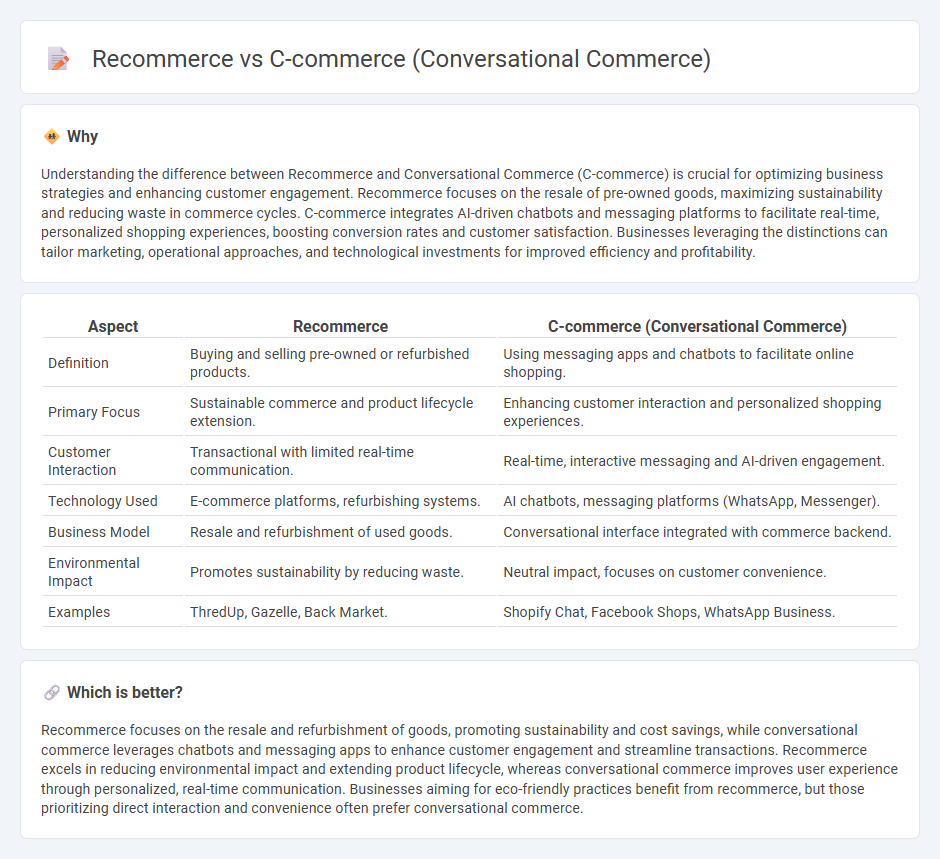
Recommerce focuses on the resale of pre-owned goods through digital platforms, promoting sustainability and cost savings for consumers by extending product lifecycles. C-commerce, or Conversational Commerce, leverages AI-driven chatbots and messaging apps to facilitate personalized shopping experiences and real-time customer interactions. Explore these evolving commerce models to understand their impact on consumer behavior and retail innovation.
Why it is important
Understanding the difference between Recommerce and Conversational Commerce (C-commerce) is crucial for optimizing business strategies and enhancing customer engagement. Recommerce focuses on the resale of pre-owned goods, maximizing sustainability and reducing waste in commerce cycles. C-commerce integrates AI-driven chatbots and messaging platforms to facilitate real-time, personalized shopping experiences, boosting conversion rates and customer satisfaction. Businesses leveraging the distinctions can tailor marketing, operational approaches, and technological investments for improved efficiency and profitability.
Comparison Table
| Aspect | Recommerce | C-commerce (Conversational Commerce) |
|---|---|---|
| Definition | Buying and selling pre-owned or refurbished products. | Using messaging apps and chatbots to facilitate online shopping. |
| Primary Focus | Sustainable commerce and product lifecycle extension. | Enhancing customer interaction and personalized shopping experiences. |
| Customer Interaction | Transactional with limited real-time communication. | Real-time, interactive messaging and AI-driven engagement. |
| Technology Used | E-commerce platforms, refurbishing systems. | AI chatbots, messaging platforms (WhatsApp, Messenger). |
| Business Model | Resale and refurbishment of used goods. | Conversational interface integrated with commerce backend. |
| Environmental Impact | Promotes sustainability by reducing waste. | Neutral impact, focuses on customer convenience. |
| Examples | ThredUp, Gazelle, Back Market. | Shopify Chat, Facebook Shops, WhatsApp Business. |
Which is better?
Recommerce focuses on the resale and refurbishment of goods, promoting sustainability and cost savings, while conversational commerce leverages chatbots and messaging apps to enhance customer engagement and streamline transactions. Recommerce excels in reducing environmental impact and extending product lifecycle, whereas conversational commerce improves user experience through personalized, real-time communication. Businesses aiming for eco-friendly practices benefit from recommerce, but those prioritizing direct interaction and convenience often prefer conversational commerce.
Connection
Recommerce and C-commerce both focus on enhancing customer engagement and sustainability in the retail sector by leveraging digital platforms and conversational interfaces. Recommerce emphasizes the resale and refurbishment of products to extend their lifecycle, while C-commerce utilizes chatbots and messaging apps to facilitate seamless, personalized shopping experiences. Together, they drive circular economy practices and improve transactional efficiency through real-time communication and eco-friendly commerce solutions.
Key Terms
C-commerce (Conversational commerce):
C-commerce leverages AI-powered chatbots and messaging platforms to facilitate personalized shopping experiences, enabling real-time customer interactions and seamless transactions. It integrates voice assistants and instant messaging to drive higher engagement and convenience compared to traditional e-commerce models. Explore how C-commerce transforms retail by enhancing customer connection and boosting sales potential.
Chatbots
C-commerce leverages chatbots to facilitate real-time, personalized shopping experiences through messaging platforms, enhancing customer engagement and conversion rates. Recommerce utilizes chatbots primarily to streamline buying and selling of pre-owned products, focusing on sustainable commerce and inventory management. Explore how chatbot-driven interactions transform both c-commerce and recommerce landscapes for deeper insights.
Messaging platforms
Conversational commerce (C-commerce) leverages messaging platforms like WhatsApp, Facebook Messenger, and WeChat to enable direct, personalized shopping experiences through chatbots or live agents, driving real-time customer engagement and seamless transactions. Recommerce focuses on the resale of pre-owned goods via these messaging channels, facilitating peer-to-peer sales and customer trust through instant communication and negotiation. Explore how integrating messaging platforms boosts both C-commerce and recommerce efficiently for increased customer loyalty and sustainable shopping practices.
Source and External Links
Conversational Commerce with Meta | PCG Digital - Conversational commerce, or C-Commerce, enables customers to connect with salespeople through social media platforms like Facebook Messenger and Instagram, blending the convenience of online shopping with personalized interaction in real-time from any location.
What Is Conversational Commerce and Why Is It Important? - Juphy - Conversational commerce is an interactive shopping experience where brands use AI, chatbots, or live representatives on messaging apps to engage customers in real-time, offering personalized support, answering queries, and facilitating faster purchase decisions.
What is Conversational Commerce? Types, Examples & Benefits - Conversational commerce leverages chatbots, live chat agents, voice assistants, and messaging apps to provide personalized, real-time customer engagement that enhances convenience and satisfaction across multiple channels beyond just social media.
 dowidth.com
dowidth.com